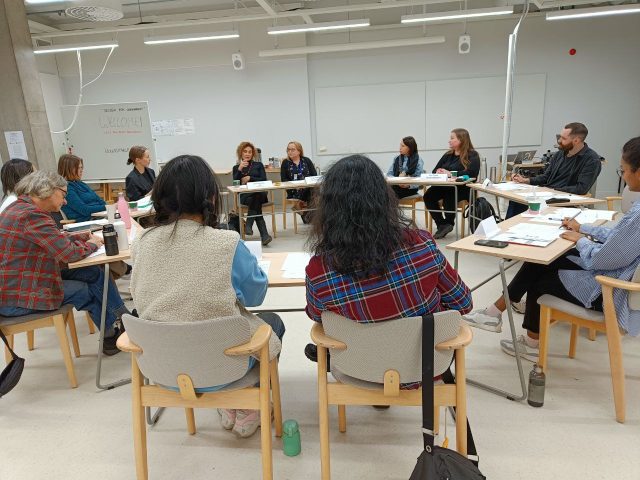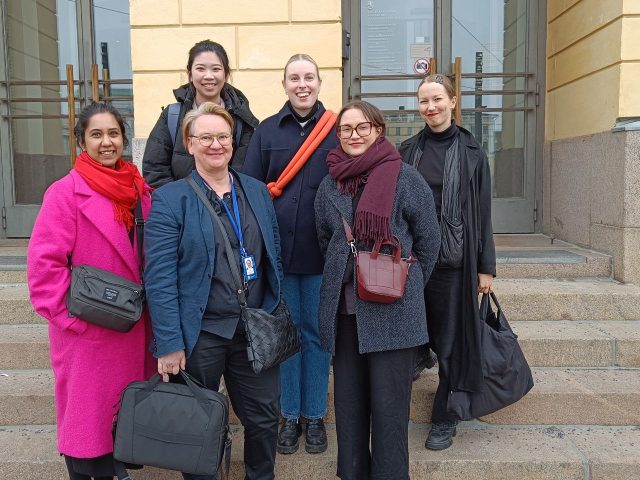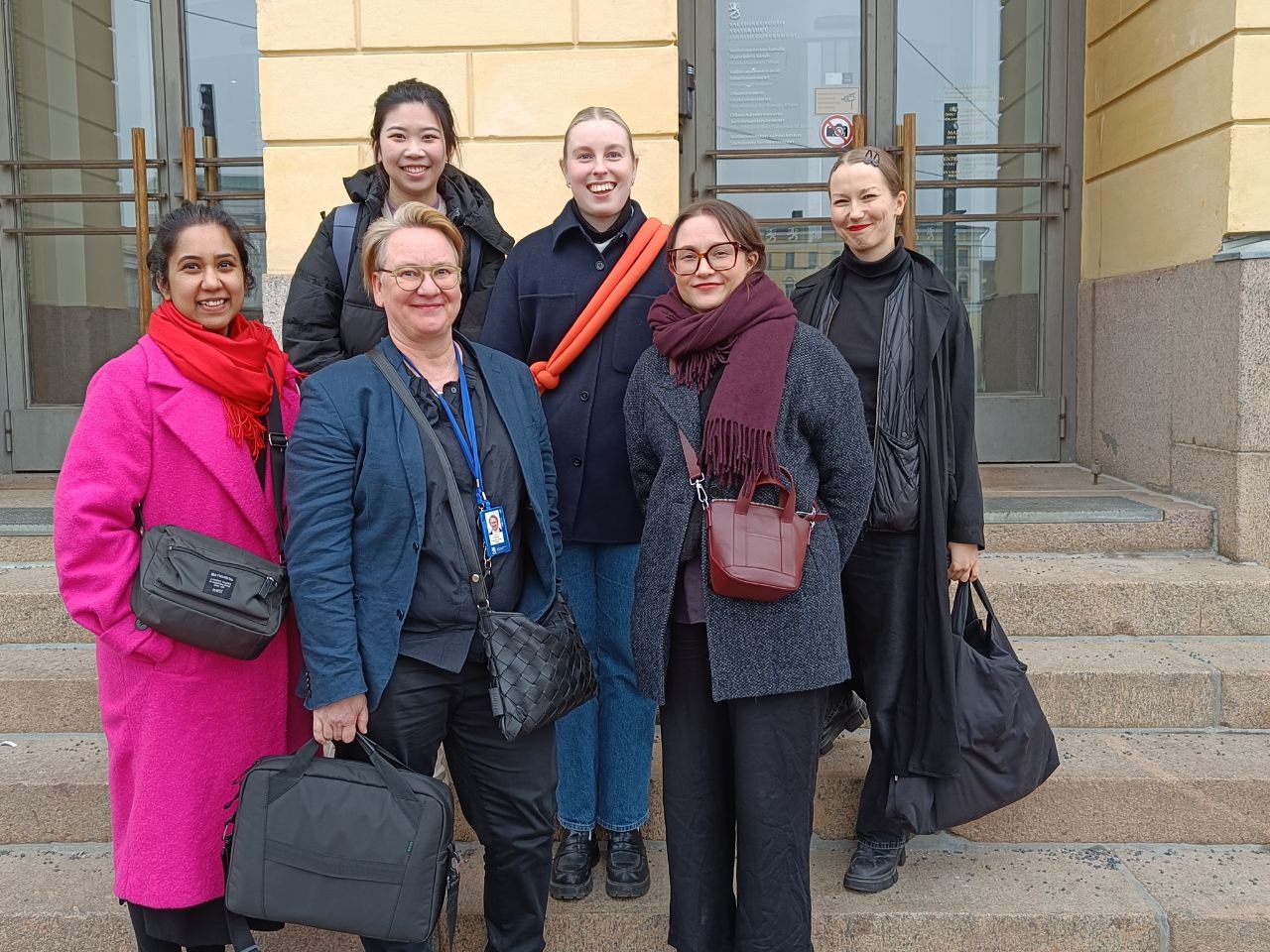This blog post will tell you about the ongoing work of the DfG course! The post is written by group A1, who are researching policy coherence and biodiversity approaches in collaboration with the Prime Minister’s Office. The group includes Meeri Aaria from the Collaborative and Industrial Design program, Arpa Aishwarya from the Urban Studies and Planning program, Kamilla Grämer from the Creative Sustainability program, and Haoyue Lei from the Environmental Design and Creative Sustainability program.
Written by: Meeri Aaria
Our world is doing worse than ever, the last time to act is now. Biodiversity is disappearing at an alarming rate in the world and Finland (Sitra, 2022). This is an all-of-government challenge, but what mechanisms can help mobilize coherent action (WHO, 2020)? How could we students help design a solution that will help us understand the scale of biodiversity, and the complexity of Finland’s governmental structures and ultimately save our planet in 12 weeks? Spoiler alert, we can’t.
We recognize that designing systems is a complex process, and we must be honest with ourselves; it is simply not possible to find a quick-fix solution in 12 weeks. Despite this, we are determined to achieve something that will benefit the Prime Minister’s office and the Ministry of Environment and of course, biodiversity, even if only on a small scale.
This blog post is the first part of four in which we will honestly and transparently share our journey through the course. We’re super excited to be here, welcome on board, and let’s get started!
Who are we?
This complex issue of biodiversity, our working brief, is simultaneously tackled during the course by three multi-disciplinary groups of students: 1A Horizontal (us), 1B Interdepartmental, and 1C Vertical. Specifically, we in the horizontal group are looking at how biodiversity-related issues are communicated between ministries.
Before we dive deeper into the subject, let me say a few words about who we have on our 1A team. We hope that this will help you, readers, to see from which angle we are looking at the issue, and from which existing. toolbox our team is starting to look for possible proposals for this challenge.
I, A first-year master’s student at Aalto University in Collaborative and Industrial Design with a strong background in customer service. In this course, I am deepening my skills by focusing on designing services and experiences and understanding complex systems from an empathic perspective.
Arpa Aishwarya. An architect by training and currently pursuing her master’s in Urban Studies and Planning at the University of Helsinki and Aalto University. Sustainable transformations are the core theme of her academic work and currently, she is exploring how participatory practices can bring systemic change.
Kamilla Grämer. A multi-disciplinary designer with a background in strategic design and visual communication. Originally trained as a graphic designer, she is currently exploring systemic design with a strong focus on sustainability transitions at the Creative Sustainability Master’s Program at Aalto University.
Haoyue Lei. A double degree, second-year master’s student from Tongji University, Shanghai, China, and Aalto University. Having an urban landscape design background, now she is majoring in Environmental Design and Creative sustainability.
So many questions, so little time!
At the beginning of the work, we started to outline the context of the work through research. We started by reading a wide range of background materials provided to us. We looked for more information as our understanding grew. Next, we began to map the complex system in which we have found ourselves into, by outlining the structure of the government in relation to the ministries, as well as the strategies, projects, and existing measures of each ministry through Systems Thinking mapping. Broadly speaking, Systems Mapping is the creation of visual depictions of a system, intended to provide a simplified conceptual understanding of a complex system (WRI, 2020).

A part of the System Thinking in Figma Jam. Instead of precise content, the picture shows that a lot of information is required to support the understanding of the functioning of government and ministries. © CREATIVE COMMONS CC BY 4.0 2024. Meeri Aaria, Arpa Aishawarya, Kamilla Grämer, Haoyue Lei. DESIGN FOR GOVERNMENT. AALTO UNIVERSITY.
On 6 March 2024, we organized a round table discussion at Aalto University with representatives from the Ministry of the Environment and the Prime Minister’s Office. The aim of the discussion was not only to get to know each other better but also to clarify our research objectives. We were interested, for example, to hear about the current situation, and how current communication is taking place between and within ministries. Who is responsible for the planning and implementation of biodiversity policies, and who and what is involved in its design?

Round table talk at Aalto University. © CREATIVE COMMONS CC BY 4.0 2024. Meeri Aaria, Arpa Aishawarya, Kamilla Grämer, Haoyue Lei. DESIGN FOR GOVERNMENT. AALTO UNIVERSITY.
After the round table discussion, we had the honor of going to the Senate Castle to meet a Senior Specialist. The meeting was attended by three students from the horizontal group, as well as students from other groups. At the meeting, we were able to ask specific – even simple, but yet important questions, which we were still thinking about after the round table discussion.

The photo shows excited people about the discussion in front of the Senate Castle. From left: Arpa Aishwarya, Lei Haoyue, Kristiina Niikkonen, Elli Törnqvist, Meeri Aaria, Sari Kukkasniemi. © CREATIVE COMMONS CC BY 4.0 2024. Meeri Aaria, Arpa Aishawarya, Kamilla Grämer, Haoyue Lei. DESIGN FOR GOVERNMENT. AALTO UNIVERSITY.
Scratching the surface
Our brief, is not an easy subject to approach, as it takes time just to understand the structures and complexities of the state. It also takes time to familiarize oneself with the different concepts and to learn a common language and vocabulary. For example, let’s think about the word biodiversity.
According to Sitra (2022), biodiversity refers to the variety of life on Earth, encompassing species diversity, genetic diversity, and ecosystem diversity, all of which are essential for the preservation of life on our planet.
Biodiversity underpins the health of people and the planet. Biodiversity erosion can harm food safety, living conditions, and social and economic systems. Unattended, it can lead to widespread instability and potential conflict (WHO, 2020).
Through our meetings, we noticed the same phenomenon: different stakeholders talk about biodiversity from their perspectives. Some of them were even a bit surprised by this. So, this leaves us with the question: how do we come to a consensus on this issue so that we can also see the perspectives of other experts, and ministries and, above all, understand the needs and value of nature’s stakeholders? Are small corrections enough for us, or do we need more radical solutions?
We will come back to this in the next part of the blog, glad you read this far!
References:
· Design for Government brief (2024): https://dfg-course.aalto.fi/2024/new-projects-of-dfg-2024/
· Sitra. Antti Lehtinen. (2022). An online course open to all provides information on biodiversity and the impacts of habitat loss. https://www.sitra.fi/artikkelit/kaikille-avoin-verkkokurssi-tarjoaa-tietoa-luonnon-monimuotoisuudesta-ja-luontokadon-vaikutuksista/
· Sitra. (2022). Tulevaisuussanasto: biodiversiteetti. https://www.sitra.fi/tulevaisuussanasto/biodiversiteetti/
· WRI – World Resources Institute. Erin Gray and Charlie Bloch. (2020). Systems Mapping — A Vital Ingredient for Successful Partnerships. https://www.wri.org/technical-perspectives/insider-systems-mapping-vital-ingredient-successful-partnerships
· WHO. Cristina Romanelli. (2020).Guidance on mainstreaming biodiversity for nutrition and health. https://cdn.who.int/media/docs/default-source/climate-change/mainstreaming-biodiversity-for-nutrition-and-health12d76606-f87e-4857-9264-dd2b2924186a.pdf?sfvrsn=afd00782_1&download=true
The DfG course runs for 14 weeks each spring – the 2024 course has now started and runs from 26 Feb to 29 May. It’s an advanced studio course in which students work in multidisciplinary teams to address project briefs commissioned by governmental ministries in Finland. The course proceeds through the spring as a series of teaching modules in which various research and design methods are applied to address the project briefs. Blog posts are written by student groups, in which they share news, experiences and insights from within the course activities and their project development. More information here about the DfG 2024 project briefs. Hold the date for the public finale on Wednesday 29 May!

